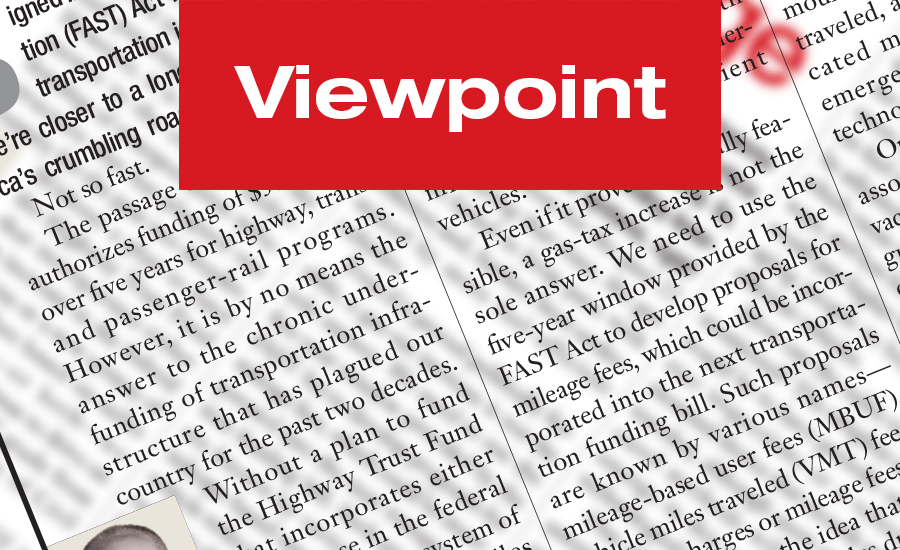
|
| Kelly |
Signed into law in December, the Fixing America’s Surface Transportation (FAST) Act finally brings some predictability to funding surface transportation infrastructure, plus a modest increase in funding. So, we’re closer to a long-term solution for maintaining and upgrading America’s crumbling roads, bridges, transit and passenger-rail systems, right?
Not so fast.
The passage of the FAST Act authorizes funding of $305 billion over five years for highway, transit and passenger-rail programs. However, it is by no means the answer to the chronic underfunding of transportation infrastructure that has plagued our country for the past two decades. Without a plan to fund the Highway Trust Fund that incorporates either an increase in the federal gas tax or a new system of user fees based on miles driven—or both—we probably will continue to drive on roads that get a “D” grade from the American Society of Civil Engineers.
Moreover, when the FAST Act expires in 2020, we could be right back where we were for the past six years, a period in which Congress has passed a series of stopgap funding bills—none of them adequate—and routinely transferred huge sums of money to bail out the bankrupt Highway Trust Fund.
The most obvious and seemingly practical solution is an increase in the federal gas tax, tied to inflation. I contend that most people would be willing to pay higher gas taxes for a better transportation system. But raising taxes is politically difficult, which is why the levy has remained at 18.4¢ per gallon for the past 22 years. During that time, the gas tax has failed to keep pace with inflation and, further, been undermined by more fuel-efficient vehicles.
Even if it proved politically feasible, a gas-tax increase is not the sole answer. We need to use the five-year window provided by the FAST Act to develop proposals for mileage fees, which could be incorporated into the next transportation funding bill. Such proposals are known by various names—mileage-based user fees (MBUF), vehicle miles traveled (VMT) fees, road-use charges or mileage fees—but they all share the idea that assessing fees based on miles driven, as opposed to fuel consumed, is an idea worth further consideration and study.
The concept might seem fanciful, but some government and industry stakeholders have been developing it for years. Building on that work, the FAST Act includes funding for pilot studies on mileage-based user fees.
Unlike the gas tax, which has been undermined by both inflation and rising fuel-efficiency, mileage-based user fees would provide a more stable and reliable funding stream and be better able to keep pace with demand. Additionally, a mileage-based user-fee system could be structured to adjust with inflation to improve further the trust fund’s long-term solvency. With user fees, motorists would pay for their use of roadways, which is more equitable than paying based on fuel consumed. User fees could be adjusted so that heavier vehicles, which cause more damage to roadways, and less fuel-efficient vehicles would pay higher fees, thus encouraging people to buy more fuel-efficient vehicles.
How can the miles traveled be monitored? The simplest solution would be to have periodic odometer inspections or a vehicle-mounted device that records miles traveled, although more sophisticated methods will no doubt emerge in this age of constant technological innovation.
One of the paramount issues associated with mileage fees is privacy, but I believe reasonable safeguards could be put in place. The cost of implementing a system to track miles driven could be prohibitive, but my guess is that, given the current pace of technological innovation, that issue also could be addressed. The RAND Corp., which has studied this issue, says that while a mileage fee system is challenging to design and more costly to run, it would offer a stable source of funding and could support other policy goals.
Let’s seize the five-year window of stability provided by the FAST ACT as an opportunity to pave the way to a rational, long-term solution to our chronic transportation funding woes.



Post a comment to this article
Report Abusive Comment